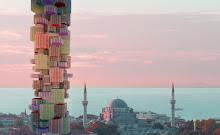An article I read on the dwindling built heritage of Macau got me thinking once again on the role of cultural heritage in the urban environment of up and coming global cities. Too often these days, centuries old buildings rich with craftsmanship and architectural detail, and social and cultural history have either been decimated in favor of a new row of generic glass towers to appeal to huge multinational corporations or super luxurious new attractions to entice that elite group of tourists. The speed of contemporary development has often prevented thoughtful development. Skyscrapers and brand new towns go from the drawing board into construction at record times all over the world in the hopes of outdoing the competition in the next city.
In this age of lightening speed technology, communications, construction and global competition, after studying this phenomenon for years and years now, I am convinced that governments of nascent global cities (by that I mean cities that are on the verge of taking a prominent place on the world's stage and becoming a key player in the global economy - like Dubai was 20 years ago) need some sort of guidelines or caveats as to how to develop an urban environment that is progressive, competitive and advanced and yet still respectful to local cultural heritage. For many of these cities, they need to realize that their architectural history is not an impediment to becoming a global city, it can be an advantage.
- Cities that are embarking on becoming a more influential player and stakeholder in the global economy and thus are going to undergo a dramatic transformation of their urban environment should at first take the time to develop a comprehensive urban strategy that allows for the construction of new infrastructure and at the same time promotes and protects your built heritage.
All to often, there is this misconception that anything that is shiny and new and very tall is much more valuable than something more historical and local. Time and time again, governments are only too hasty to abandon and destroy their own culture and heritage in favor of something they think will make them more globally appealing, more modern, more attractive to global businesses and tourists, and
seem less backward. What is often lost in this process, however, is that local heritage and culture can be an incredibly appealing resource. A unique identifier and symbol that gives a city an identity that goes beyond the homogeneity of curtain wall high rises.
- Built heritage can be an economic driver
Singapore in the 1970's is a classic example. For close to two decades, this city-state fought to advance itself as a premier global city. All things foreign were valued over anything local. Historic buildings were destroyed so that foreign big name architects could build technologically advanced towers. However, by the mid 1980's the toll of all this destruction started to concern the government and local architectural and planning communities. The city lacked soul and identity and tourism, a huge revenue generator, was dramatically dropping. So as part of a new strategy to halt this trend, ethnic enclaves such as Chinatown, Little India, Kampong Glam and Heritage Link were conserved and redeveloped into mixed use buildings combining residential with commercial. These are now all bustling centers within the city. Years later Singapore continues to protect their older neighborhoods like this one below:
 This row of shophouses on Joo Chiat Road dating back to the 1920's and 1930's was deemed a conservation district in 1993. The owners of the shophouse in the middle, Chiang Ian and Yang Yeo restored the front facade and renovated the interiors giving their home a very contemporary feel without losing the history of the building. (These pictures and the story are from Dwell.)
This row of shophouses on Joo Chiat Road dating back to the 1920's and 1930's was deemed a conservation district in 1993. The owners of the shophouse in the middle, Chiang Ian and Yang Yeo restored the front facade and renovated the interiors giving their home a very contemporary feel without losing the history of the building. (These pictures and the story are from Dwell.)

In Damascus, Syrian expatriates returned home and have turned their decaying 'Old City' into an elite hot spot of boutique firms, entertainment, restaurants and clubs - a huge economic driver withing the city. They have done this by restoring the old buildings and adapting their original use.
 Beit Al Mamlouka - the first boutique hotel in Damascus located in the Old City
Beit Al Mamlouka - the first boutique hotel in Damascus located in the Old City
- Don't be so consumed with chasing FDI and tourists that you forget your obligation to your own citizens.
According to the article "
Searching for Macau's cultural future," Rua da Tercena and Rua de Cinco de Outubro, two century-old streets right adjacent to "the historic center of Macao", a UNESCO World Heritage Site are eerily silent in part because the street and buildings are falling apart from neglect. That wasn't always the case however. It used to be a bustling commercial street. Macanese lawyer and cultural advocate Miguel de Senna Fernandes claims that the downfall of these streets are the result of the government's narrow focus on building up the flashier tourist attractions. According to Fernandes, government projects for the past few years have been all geared towards the interests of the casinos and those who visit them. When I visited Macau many many years ago, it was charming albeit sleepy town. The buildings and culture of Macau have a unique blend of Portuguese and Chinese sensibilities and architectural influences, found no where else in the world. Now however, it has been overrun with American casino operators like Wynn, MGM Grand and Sheldon Adelson's Venetian. Macau's casino revenues apparently exceed that of Las Vegas. Obviously these profits are also a huge boost to the economy of Macau. However, if Macau is to retain some of its original character, charm and soul, then the government can take some of the revenue generated from the casinos and invest in conserving up their own built heritage and nurturing their own local businesses, artists, craftsmen and performers.
 Antiques' merchant So Mo Cheung based on Rua da Tercena for decades
Antiques' merchant So Mo Cheung based on Rua da Tercena for decades
(Image from CNN.com)
In the early 1990's, the leaders of Dubai freely bulldozed over whatever minimal built heritage they had. Nothing was spared not even their former leaders' old homes. Years later they realized that their built heritage could be used as an economic driver and so they sought to rebuild their heritage which is what you see when you walk through the
'historic' Bastakiya Quarter. Well you know how sometimes when you walk into an old historic building, you feel like if the walls could talk they would tell you great stories of years past and the people who inhabited the space long long ago? Well, you won't feel much of anything now when you walk through the Bastakiya Quarter because the place is sterile. It is so pristine because most of it has been rebuilt from scratch.
 Reconstructed Windtowers in the Bastakiya Quarter
Reconstructed Windtowers in the Bastakiya Quarter
The same is happening in Beijing. They decimated
Qianmen, a centuries old shopping street with all its extraordinary buildings and in its place recreated an inferior Disneyland-like substitute. Perhaps that is a better alternative to historic sites that have vanished all together? 30,995 historic sites on an incomplete list from 1982 of 225,000 sites have already disappeared in China. According to He Shuzhong, of the Beijing Cultural Heritage Protection Center, "The last 20 years have been the worst time for cultural heritage site protection with rapid development. It is even worse than in the Cultural Revolution."
When development happens in a blink of an eye, local governments have to partner with local cultural organizations, businesses, entrepreneurs, architects, urban planners and other experts so that there can be an more engaged, robust dialogue as to how a global city should be developed, designed and built. There has to be a smarter way of countering this endless pattern of cultural destruction then hasty reconstruction in so many cities. Thoughtful more holistic strategies to urban development must be developed far in advance and not as an after thought.
 This row of shophouses on Joo Chiat Road dating back to the 1920's and 1930's was deemed a conservation district in 1993. The owners of the shophouse in the middle, Chiang Ian and Yang Yeo restored the front facade and renovated the interiors giving their home a very contemporary feel without losing the history of the building. (These pictures and the story are from Dwell.)
This row of shophouses on Joo Chiat Road dating back to the 1920's and 1930's was deemed a conservation district in 1993. The owners of the shophouse in the middle, Chiang Ian and Yang Yeo restored the front facade and renovated the interiors giving their home a very contemporary feel without losing the history of the building. (These pictures and the story are from Dwell.)

























